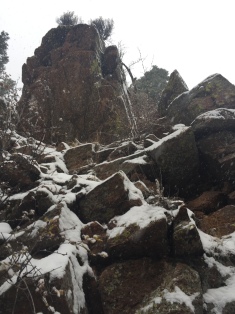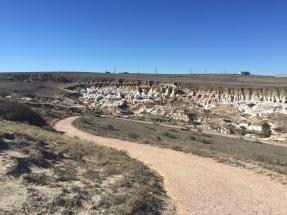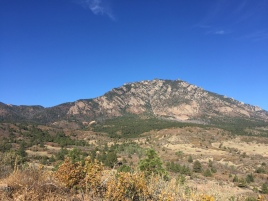Somehow, the holidays, or at least their entourage of decor, music, scents, foods, and advertisements, seem to arrive earlier every year. This has absolutely nothing to do with the topic of this post, but it does help explain the title. As promised, this post will cover how to keep Jack Frost from nipping away your fingers, ears, noses, toeses, and other body parts, as well as how to prevent catastrophic organ failure.
Yes, that took an unexpectedly dark turn, but as frightening as frostbite it, it’s hypothermia that is the real killer when it comes to cold weather camping. We’ll address both topics here, covering their symptoms, prevention, and treatment options. As usual, while I have been trained in first-aid, I have no qualifications as a trainer or medical professional, so I do not recommend using this blog as your ultimate guide to outdoor medicine. If you want more details, I highly recommend seeking out a local Red Cross First-Aid or Wilderness First Aid course. We discussed these here, by the way.
Frostbite
Frostbite is actually the a category of cold-related ailments: it includes frostnip, minor frostbite, and severe frostbite. All of these follow the same principle. As the body’s core temperature decreases, your body is designed to ensure that the internal organs maintain homeostasis, since if their temperature dips below about ninety degrees, the various chemical reactions that keep your body operational tend to slow down and even stop entirely, which is a problem. To prevent this, your body will contract the blood vessels in your extremities, preventing blood from flowing as easily, and keeping it hot in your core. Hence, your fingers, toes, and facial features, which all serve as wonderfully effective radiator panels during hot weather, are sacrificed for the greater good. Essentially, your body is automatically determining that living without a couple of digits is better than not living at all.
The symptoms are what you might expect: the skin will feel cool or cold to the touch, even icy. It may also take on a waxy (and eventually brittle) texture. There will also be discoloration, starting with pale and progressing through various shades of bruise-like colors. These colors come because of the ice crystals that are forming. When the kinetic energy of liquid water decreases sufficiently for it to undergo a phase chase, it assembles itself into a very precise crystalline lattice, which results in ice possessing a lesser density than liquid water. This was important for the survival of life on early earth, and is a fancy way of saying that water expands when it turns to ice. When the water in your body (which is some 70-90% water, depending on what statistics you choose to believe) freezes, it expands into sharp crystals, slicing through your cells and blood vessels like little, icy daggers.
This takes us nicely into treatment, because we need to dispel a myth. If you, or someone else, has any level of frostbite, do not rub the area. Remember those icy daggers we were discussing? If you rub a frostbitten area, you’ll be taking all of those icy daggers and slashing wantonly through cells all over the place, like some kind of deranged, berserker warrior. Instead, you’ll want to warm the area gradually, and keep it from being frostbitten again. Unfortunately, once you’ve had any level of frostbite, the affected area will become more susceptible to frostbite in the future.
Hypothermia
To me, hypothermia is the far more dangerous ailment. Although frostbite gives clear evidence of it presence, announcing itself in no uncertain terms, hypothermia stalks its prey more subtly, and if you’re not careful, you’ll never notice it until it may be too late. It doesn’t even have to be cold for hypothermia to set it: under the right conditions, any temperatures below human body temperature can result in hypothermia. I knew someone who got hypothermia when it was sixty degrees and sunny, because it was a little windy and he got wet.
What is this cold-weather assassin? It is a lowering of the body’s temperature. We mentioned homeostasis when discussing frostbite, and how the body pulls blood to the core and keeps it there to try to keep the important organs at the proper temperature. Hypothermia is, essentially, what happens when that fails, and your core temperature starts to decrease. If it dips below about 85 degrees (Fahrenheit), there’s a pretty good chance of death. Since the body is such an intricate, bio-chemical system, this decrease in temperature prevents reactions from proceeding properly, and eventually everything will simply shut down.
There are a lot of hypothermia symptoms, and they overlap significantly with other ailments. This will be an incomplete list, but more important than knowing all of the specific systems will be knowing the people with whom you’re outdoors. That way, you’ll be able to identify if they’re acting out of the ordinary. Some common symptoms include: shivering, disorientation, dizziness, lack of hand-eye coordination, decreased ability to perform complex mental tasks, irritability, irrationality, lethargy, and nausea.
Treatment of hypothermia is just as simple as treatment for heat-related illnesses: you need to bring their core temperature back to normal. Easy in theory, but sometimes challenging in practice. If they are wet, get all of their wet clothes off of them. For that matter, even if they don’t seem wet, get all of their clothes off them and get them into some clean, dry clothes. Even if you don’t think their clothes are wet, they’ve probably sweated, and changing their clothes will help to provide better insulation. However, they don’t currently have the heat in their core to make use of that insulation, so you’re not going to want to put them back in clothes right away. You’re going to need to get them near a heat source, and trap that heat source with them. The best way to do this is to get in a sleeping bag with them. Before you all go saying that this is weird, allow me to remind you that their organs will eventually start shutting down, their body temperature will continue to drop, and they will eventually die if you don’t do something to warm their core. It’s also a good idea to put warm water bottles or hand warmers at their major arteries: neck, armpits, groin. I actually carry those little hand warmers for precisely that purpose (they’re a bad idea under normal circumstances, because they make you sweat, and sweating is bad when it comes to staying warm).
Depending on where you are, treating any of these ailments could simply involve going inside, but if you’re in the backcountry, treatment could be more complicated. Prevention is a much better option, and we’ll continue discussing how to stay comfortable as winter matures. If you do suffer from either frostbite or hypothermia in their extreme forms, I would strongly encourage you to get checked out by a medical professional after you return.
I’m by no means encouraging anyone to use this as an excuse to avoid winter camping. With the proper preparation and knowledge, you’ll not have any issues, and if you know how to identify them, you can address them before they become truly dangerous.
*Disclaimer: As usual, I must remind you that I am not a medical professional, and do not have a certification to teach these sorts of subjects. Ultimately, you are responsible for your own adventure.







